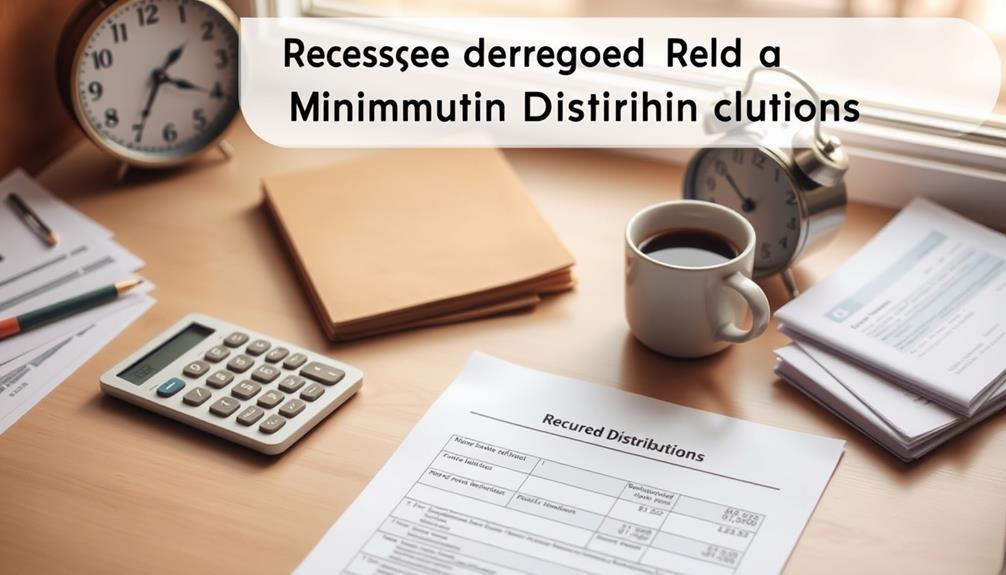When you receive an IRA as an inheritance, it is important to be aware of the regulations in order to avoid costly errors. The classification of your beneficiary is crucial—eligible designated beneficiaries (EDBs) can stretch out distributions over their lifetime, while non-eligible designated beneficiaries (NEDBs) must withdraw the entire balance within ten years. Spousal beneficiaries have the option to treat the IRA as their own and postpone required minimum distributions (RMDs). Failure to adhere to RMD regulations can result in significant penalties. Take into consideration the tax implications, as they differ between traditional and Roth IRAs. Understanding these specifics can help you maximize the benefits of your inherited IRA. There is much more to explore.
Key Takeaways
- Understand the distinction between Eligible Designated Beneficiaries (EDBs) and Non-Eligible Designated Beneficiaries (NEDBs) to optimize withdrawal strategies and tax implications.
- Ensure compliance with Required Minimum Distributions (RMDs) to avoid hefty penalties, especially for non-spousal beneficiaries.
- Recognize the 10-year payout rule for NEDBs, requiring total distribution by the end of the tenth year after the account holder's death.
- Seek professional guidance to navigate classification, distribution strategies, and tax obligations effectively, ensuring informed decision-making.
- Keep updated on IRS regulations and changes to avoid costly misunderstandings about inherited IRA rules.
Understanding IRA Basics

An Individual Retirement Account (IRA) is a powerful tool for saving for your retirement, established under the Employee Retirement Income Security Act (ERISA) of 1974. With an IRA, you can accumulate IRA money in a tax-advantaged way, helping you prepare for your financial future.
There are two common types of IRAs: Traditional IRAs and Roth IRAs. Traditional IRAs offer tax deductions on your contributions, meaning you won't pay taxes until you withdraw the funds in retirement. In contrast, Roth IRAs require you to pay taxes on your contributions upfront, allowing for tax-free withdrawals later on.
Additionally, understanding how to convert retirement savings into a Gold IRA may provide an extra layer of protection against market volatility. It's crucial to understand the contribution limits for IRAs, which are generally lower than those for employer-sponsored 401(k) plans and can change annually based on IRS regulations.
Another critical aspect of IRAs is the concept of a designated beneficiary. This person is specifically named in the IRA documentation and plays a significant role in how the account's funds are distributed upon your death. Knowing the differences between spousal and non-spousal beneficiaries can also impact how the IRA money is managed after you're gone, so be sure to reflect on this when naming your beneficiary.
Inheriting an IRA

When you inherit an IRA, understanding your classification as a beneficiary is essential, as it affects your withdrawal options and timing.
For instance, knowing about Common Financial Terms and Jargon can help you navigate your options more effectively.
Spousal beneficiaries can choose a stretch IRA, while non-spousal beneficiaries must adhere to the 10-year payout rule.
Additionally, you'll need to take into account the tax implications of your distributions to develop effective withdrawal strategies.
Beneficiary Classification Importance
Understanding beneficiary classification is essential because it directly affects how inherited IRAs are distributed and taxed. The classification types—Eligible Designated Beneficiaries (EDBs), Non-Eligible Designated Beneficiaries (NEDBs), and Non-Designated Beneficiaries (NDBs)—determine the rules you must follow.
EDBs, like spouses and minor children, can take advantage of the stretch IRA strategy, allowing them to spread distributions over their lifetimes. In contrast, NEDBs must adhere to the SECURE Act's 10-year payout rule, which can lead to significant tax implications.
Additionally, utilizing a Gold IRA can provide further benefits for heirs, as it allows for tax-deferred growth and resilience against economic downturns, making it a valuable asset to inherit long-term capital appreciation.
Misclassifying a beneficiary can be costly. For example, NEDBs must withdraw the entire IRA balance within ten years, which might push them into a higher tax bracket if they're not careful.
The SECURE Act, effective from 2020, changed the landscape for those inheriting IRAs, imposing stricter rules that didn't apply to earlier beneficiaries. Failing to understand these classifications can result in penalties or missed required minimum distributions (RMDs).
Withdrawal Timing Strategies
Proper timing of withdrawals from an inherited IRA can greatly influence your financial situation and tax obligations. As a non-spousal beneficiary, you must withdraw the entire balance within 10 years, but there are no specific annual withdrawal amounts. This flexibility means you should carefully consider your withdrawal timing strategies, as distributions can affect your tax bracket considerably.
Additionally, understanding the implications of different investment options, such as those offered by reputable companies like Noble Gold, can enhance your decision-making process regarding your inherited IRA.
If you're a spousal beneficiary, you have the option to treat the inherited IRA as your own, allowing you to defer withdrawals until you reach age 72. This can provide enhanced tax planning opportunities.
Regardless of your beneficiary status, you'll need to adhere to required minimum distributions (RMDs) if applicable, as missing these can lead to hefty penalties.
When planning your withdrawals, weigh the pros and cons of annual withdrawals versus lump-sum distributions. Annual withdrawals might help you manage your cash flow while keeping you in a lower tax bracket, whereas a lump-sum distribution could push you into a higher bracket, resulting in more taxes.
Strategically timing your withdrawals can optimize your tax treatment and help you make the most of your inherited IRA.
Tax Implications Overview
Inheriting an IRA can have significant tax implications that you'll need to navigate carefully. Depending on the type of IRA, you may face different tax responsibilities. For example, if you inherit a Traditional IRA, you'll need to pay income tax on distributions, while Roth IRAs may allow for tax-free withdrawals, depending on the account's age and contribution timing.
Additionally, understanding the tax implications of IRA rollovers can be essential for optimizing your inherited assets.
Here are some key points to keep in mind:
- Non-spouse beneficiaries must adhere to the 10-year payout rule, meaning you'll need to withdraw the entire balance by the end of the tenth year after the original owner's death.
- Eligible designated beneficiaries (EDBs) can utilize the stretch IRA strategy, allowing you to take distributions based on your life expectancy, which can minimize immediate tax liabilities.
- Be aware that failing to withdraw required minimum distributions (RMDs) on time can incur a hefty 50% penalty on the undistributed amount.
To avoid pitfalls, it's wise to consult with tax professionals who can help you understand the complex tax implications of your Inherited IRA and guarantee you comply with all rules.
Required Minimum Distributions

Required Minimum Distributions (RMDs) are an essential aspect of managing inherited IRAs. If you're a non-spousal beneficiary, you need to withdraw the entire balance within ten years after the SECURE Act, but there's no specific withdrawal rate you must follow during that time.
It's important to consult with a financial advisor to understand the implications of these distributions and to avoid potential pitfalls in your retirement planning. However, you must take annual RMDs, and failing to do so can lead to a hefty 50% penalty on the amount you should've withdrawn.
Spousal beneficiaries have more flexibility, as they can treat the inherited IRA as their own, which changes the RMD requirements and can impact tax implications.
If you qualify as an eligible designated beneficiary (EDB), like a minor child or an individual with disabilities, you can stretch your distributions over your lifetime instead of being bound by the ten-year rule.
Additionally, understanding the risks and rewards of Bitcoin IRAs may also be advantageous for those considering diverse investment options within their retirement strategy.
Tax Implications for Beneficiaries

When you inherit an IRA, understanding your beneficiary classification is vital because it directly affects your tax obligations.
For instance, knowing the essential queries before precious metals investment can help you make informed decisions about your inherited assets.
If you're a non-spousal beneficiary, you'll need to navigate the 10-year payout rule, which can complicate your tax situation.
Missing required minimum distributions can also lead to hefty penalties, so it's wise to consult a tax professional for guidance.
Beneficiary Classification Impacts Taxes
Understanding how beneficiary classification impacts taxes is vital for effective financial planning. The way you're classified as a beneficiary can greatly influence your tax obligations when dealing with an inherited IRA.
Individuals facing emotional dysregulation, such as those with Borderline Personality Disorder, may benefit from structured financial advice to avoid additional stress during complex situations like inheritance.
Here are the main classifications and their implications:
- Eligible Designated Beneficiaries (EDBs) can stretch distributions over their lifetime, allowing for prolonged tax deferral.
- Non-Eligible Designated Beneficiaries (NEDBs), like most non-spouse beneficiaries, must follow the 10-year rule, which can spike your taxable income during certain years.
- Non-Designated Beneficiaries (NDBs) face immediate taxation on the entire inherited amount, increasing your tax burden.
Misclassifying a beneficiary can lead to unexpected tax consequences, as each classification has distinct tax rates and distribution options.
It's important to consult with a tax professional to confirm you understand your beneficiary classification. Knowing how these classifications affect your tax rate can help you make informed decisions about distributions and tax planning.
RMDs and Tax Obligations
Managing the rules around Required Minimum Distributions (RMDs) can be intimidating for beneficiaries of inherited IRAs. As a non-spousal beneficiary, you'll need to withdraw the full account balance within 10 years of the account owner's death, thanks to the SECURE Act.
Understanding the tax implications of these withdrawals is vital, especially since distributions from Traditional IRAs are subject to income taxes, while Roth IRAs generally allow for tax-free withdrawals. Additionally, many beneficiaries may explore various online earning opportunities to help manage any associated financial burdens during this time.
If you fail to comply with the 10-year withdrawal requirement, you could face penalties of up to 50% on any undistributed amount. RMDs must also be taken in conduit trusts and are reported on your personal tax return, which can affect your overall tax liability.
It's important to know whether you're classified as an Eligible Designated Beneficiary or a Non-Eligible Designated Beneficiary, as this distinction considerably impacts your RMD obligations and the associated tax implications.
To navigate these rules effectively, stay informed about your inherited IRA's requirements and consult a tax professional if needed. This proactive approach will help you avoid pitfalls and manage your tax responsibilities efficiently.
Common Mistakes to Avoid

Often, beneficiaries overlook vital details when maneuvering IRA inheritance rules, leading to costly mistakes. You need to be particularly cautious with Inherited IRAs, as a few common pitfalls can greatly increase your tax liabilities or penalties. The importance of understanding sector diversification as a risk management strategy can also extend to the management of inherited assets, ensuring that your financial legacy is protected.
- Failing to seek professional guidance: A fiduciary fee-only Certified Financial Planner (CFP) can help you navigate the complexities of retirement accounts and avoid errors.
- Confusing pre-2020 and post-2020 rules: Mixing these rules, especially with the new 10-year withdrawal requirement for non-spouse beneficiaries, can lead to misunderstandings and penalties.
- Ignoring Required Minimum Distributions (RMDs): Neglecting RMDs can result in hefty penalties. Make sure you're compliant with withdrawal schedules to avoid unnecessary fines.
Taking a lump-sum distribution without proper tax planning can also result in excessive taxation, reducing the amount you inherit.
Additionally, understanding the difference between Eligible Designated Beneficiaries (EDBs) and Non-Eligible Designated Beneficiaries (NEDBs) is essential to managing your tax obligations effectively. By avoiding these common mistakes, you can protect your inheritance and make informed decisions moving forward.
Distribution Strategies

When it comes to distributing your inherited IRA, choosing the right strategy can greatly impact your financial future. You have options, and understanding them is key. One popular choice is a lump-sum distribution, but be cautious: this can lead to excessive taxation if you don't plan accordingly.
Non-spousal beneficiaries must also follow the 10-year payout rule, which requires you to withdraw the entire balance by the end of the tenth year after the account holder's death.
If you're a spousal beneficiary, you have the unique advantage of treating the inherited IRA as your own. This allows you to defer taxes until you decide to withdraw funds, which can provide significant tax benefits. Additionally, you won't incur the typical 10% penalty for early withdrawals from inherited IRAs, offering you more flexibility.
When evaluating your options, consider your financial needs and goals. You might prefer annual withdrawals to spread out your tax implications over the years instead of a lump-sum distribution.
Ultimately, the right distribution strategies can help you maximize your inheritance while minimizing tax burdens.
Importance of Professional Guidance

How can you navigate the complexities of inherited IRA rules without falling into costly traps? The key is to seek professional guidance. Consulting a fiduciary fee-only Certified Financial Planner (CFP) can help you understand the intricate rules surrounding inherited IRAs. They'll guarantee you avoid errors and properly classify beneficiaries.
Additionally, tax professionals are invaluable in clarifying tax implications, including the nuances of the 10-year payout rule and potential penalties for non-compliance. Regular updates from financial advisers can also keep you informed about changes in regulations, helping you avoid pitfalls associated with outdated information.
Here are a few reasons to evaluate professional help:
- Personalized Distribution Strategy: Tailor a distribution plan that fits your financial goals.
- Tax Implications: Understand how inherited IRAs affect your tax situation and what strategies minimize liabilities.
- Long-Term Planning: Estate planners can help you grasp the future responsibilities and implications of inherited IRAs.
Frequently Asked Questions
What Are the Rules for a Beneficiary of an Inherited Ira?
As a beneficiary of an inherited IRA, you need to know the distribution rules. Depending on your status, you might face a 10-year payout rule or have options for lifetime distributions. Always consult a tax professional.
How Do I Avoid Paying Taxes on My Inherited Ira?
If you inherit a Traditional IRA worth $100,000, consider rolling it into a Roth IRA. You'll pay taxes now, but future withdrawals will be tax-free, helping you manage your long-term tax burden effectively.
What Is the Best Thing to Do With an Inherited Ira?
When you inherit an IRA, consider your options carefully. You can withdraw the funds as needed or transfer it into your own IRA. Consulting a tax advisor helps you make the best choice for your situation.
What Is the Best Way to Pass an IRA on to Heirs?
To pass an IRA on to your heirs effectively, designate clear beneficiaries, review them regularly, consider trusts for control, and consult a financial advisor to minimize taxes and guarantee your wishes are fulfilled.
Conclusion
Maneuvering IRA inheritance rules can feel overwhelming, but you can avoid costly mistakes with the right knowledge. Did you know that nearly 70% of beneficiaries cash out their inherited IRAs, often facing hefty tax bills? By understanding the distribution strategies and tax implications, you can protect your inheritance and maximize its benefits. Don't underestimate the importance of professional guidance—having an expert by your side can make all the difference in securing your financial future.









